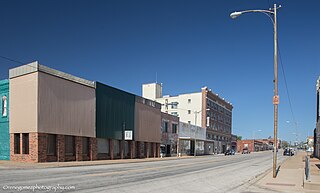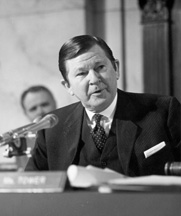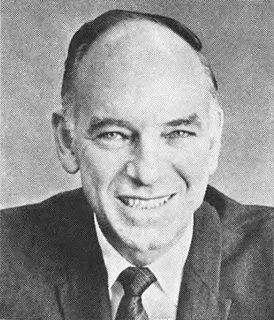
Wichita County is a county located in the U.S. state of Texas. As of the 2010 census, its population was 131,500. The county seat is Wichita Falls. The county was created in 1858 and organized in 1882.

Ranger is a city in Eastland County, Texas, United States. The population was 2,468 at the 2010 census. Ranger College, a community college, is the second-largest employer in the community.

Dublin is a city located in southwestern Erath County in Central Texas, United States. The population was 3,654 at the time of the 2010 census, down from 3,754 at the 2000 census.

John Goodwin Tower was an American politician, serving as a Republican United States Senator from Texas from 1961 to 1985. He was the first Republican Senator elected from Texas since Reconstruction. Tower also led the Tower Commission, which investigated the Iran-Contra Affair, and was an unsuccessful nominee for U.S. Secretary of Defense in 1989.

Robert Allan Shivers was an American politician who served as the 37th Governor of Texas. Shivers was a leader of the Texas Democratic Party during the turbulent 1940s and 1950s, and also developed the lieutenant governor's post into an extremely powerful perch in state government.

Poolville is an unincorporated community in Parker County, Texas, United States located along Farm Road 920, about seventeen miles northwest of Weatherford, the county seat. It has a population of 2,325 people and a school district with three campuses, a seed company, Snyder and Sons elevator, Williams Barbershop, a post office, a convenience store, a storage facility, and 2L Custom Trucks. There are five churches: Methodist, Southern Baptist, Church of Christ, The Lone Star Church of Poolville Texas, and Oak Tree Baptist Church. The United Methodist and the Church of Christ Church buildings are located just west of the town square behind the seed company.

Frank Neville Ikard was a Democratic United States Representative from Texas' 13th congressional district, centered about Wichita Falls, Texas.
KCLE is a commercial AM radio station, in Burleson, Texas. It serves the Dallas–Fort Worth metroplex and is under ownership of Tron Dinh Do, through licensee Intelli, LLC. KCLE broadcasts Vietnamese language music and talk, from a network based in California.

Graham Boynton Purcell Jr., was a United States representative from Texas' 13th congressional district.
Kenneth Ray Farabee was an attorney in Austin, Texas, who served as a Democratic member of the Texas State Senate from Wichita Falls from 1975 to 1988. He is credited with the authorship of 245 Senate bills that became law during his 13-year tenure. In 1985, he was the Senate President Pro Tempore. He is the father of former State Representative David Farabee of Wichita Falls.

George Charles Butte was a jurist, educator, and Republican politician from the U.S. state of Texas, who was his party's gubernatorial nominee in 1924 against the controversial Democrat Miriam Wallace "Ma" Ferguson, the first woman elected as governor in the United States. Subsequently, U.S. President Herbert Hoover appointed Butte as associate justice of the Supreme Court of the Philippine Islands, a position which he held from July 1, 1932, until February 1, 1936.
Frank Kell Cahoon, Sr., was an oilman and natural gas entrepreneur from Midland, Texas, who was the only Republican member of the Texas House of Representatives in the regular 1965 legislative session. Cahoon served two terms in the legislature from 1965 to 1969.
The Wichita Falls and Southern Railroad Company was a railroad in operation in North Texas from 1921 to 1954. It was incorporated in 1920 by several investors, most prominently Frank Kell and his brother-in-law, Joseph A. Kemp, both of Wichita Falls, Texas.
The Wichita Falls Railway is a defunct railroad that extended for eighteen miles from Wichita Falls to Henrietta in Clay County in North Texas, where it joined the larger Missouri, Kansas and Texas Railroad, often called the "Katy". The railway was built between 1894 and 1895 by the entrepreneur Joseph A. Kemp.
George Edwin Bailey Peddy was a Texas lawyer and politician who ran in 1922 as a combination Independent Democrat/Republican write-in candidate for the United States Senate and in 1948 as a Democrat, losing both times.

Kell House Museum, also known as The Kell House, is a historic house museum in Wichita Falls, Texas. The house was occupied from 1909 until 1980 by members of the family of Frank Kell, who made a fortune in railroads, flour milling and oil. Kell and his brother-in-law, Joseph A. Kemp, are considered the two leading business promoters of Wichita Falls in the early decades of the 20th century.
James Boisfeuillet Frank is a businessman from Wichita Falls, Texas, who is a Republican member of the Texas House of Representatives from District 69, which encompasses Archer, Baylor, Clay, Foard, Knox, and Wichita counties in North Texas.
Thaddeus Thomson Hutcheson, Sr., known as Thad Hutcheson, was a Republican attorney in his native Houston, who was an early figure in the movement to establish a competitive two-party system in the U.S. state of Texas.




























